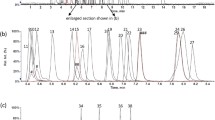Summary
Acridine and 5,6-benzoquinoline have been studied extensively byin situ fluorimetry in an attempt to evaluate the potential of this method for quantization of mixtures of polynuclear aza heterocyclic hydrocarbons in polluted air samples. The stabilities of naturally fluorescing acridine and 5,6-benzoquinoline were found to be sufficient for quantitative work if processed in the dark. Between 4 and 6% rel. S. D. and 2 and 3% rel. S. D. respectively are reported for these two compounds after onedimensional chromatography. Improvements of 3 to 5% rel. S. D. were achieved with the use of an internal standard in conjunction with twodimensional chromatography. Spraying with trifluoroacetic acid to render nonfluorescent aza arenes such as phenazine fluorescent did not produce a sufficiently stable derivative to permit quantitative analysis. Visual and instrumental detection limits of 0.005μg/spot are reported for this method, with linear calibration curves of fluorescenceversus concentration extending up to 0.5μg/spot. The optimum range of analysis is reported to be 0.1 to 1μg/spot.
Zusammenfassung
Um die Eignung der Fluoreszenzmessung zur Analyse von Gemischen mehrkerniger Azaverbindungen in Luftproben zu prüfen, wurden Acridin und 5,6-Benzochinolin eingehend untersucht. Die Stabilität dieser Substanzen ist hinreichend für eine quantitative Arbeit, wenn sie unter Lichtabschluß durchgeführt wird. 4 bis 6 Rel.-% bzw. 2 bis 3 Rel.-% Standardabweichung wurden bei eindimensionaler Chromatographie der beiden Verbindungen gefunden. Durch Verwendung eines inneren Standards und durch zweidimensionale Chromatographie wurden diese. Werte um 3 bis 5 Rel.-% verbessert. Sprühen mit Trifluoressigsäure, um nichtfluoreszierende Azaverbindungen wie Phenazin zur Fluoreszenz zu bringen, führte nicht zu genügend stabilen Derivaten, um eine quantitative Analyse zu ermöglichen. Nachweisgrenzen von 0,005μg je Fleck sind mit der angegebenen Methode erreichbar. Die Eichkurven zeigen die lineare Abhängigkeit der Fluoreszenz von der Konzentration bis zu 0,5μg je Fleck. Das bestgeeignete Bereich liegt zwischen 0,1 und 1μg je Fleck.
Similar content being viewed by others
References
C. E. Searle, Proc. Soc. Analyt. Chem.6, 11 (1969).
B. L. van Duuren, J. Natl. Cancer Inst.25, 53 (1960).
E. Sawicki, Talanta16, 1231 (1969).
A. van Langermeersh, Chim. analytique50, 3 (1969).
G. B. Engel andE. Sawicki, J. Chromatography31, 109 (1967).
R. W. Frei, J. Lawrence, andP. E. Belliveau, Z. analyt. Chem., im Druck.
R. Klaus, J. Chromatography40, 235 (1969).
R. W. Frei, H. Zürcher, andG. Pataki, J. Chromatography45, 284 (1969).
R. W. Frei, A. Kunz, G. Pataki, T. Prims, andH. Zürcher, Analyt. Chim. Acta49, 527 (1970).
E. Sawicki, J. E. Meeker, andM. J. Morgan, Intern. J. Air Water Pollution9, 291 (1965).
K. J. Bombaugh, Can. Research and Development2, 41 (1969).
Author information
Authors and Affiliations
Additional information
On study leave from Robapharm Ltd., Basle, Switzerland.
Rights and permissions
About this article
Cite this article
Frei, R.W., Zürcher, H. A quantitativein situ fluorimetric study of acridine and 5,6-benzoquinoline after thin-layer chromatographic separation from similar air pollutants. Mikrochim Acta 59, 209–219 (1971). https://doi.org/10.1007/BF01219617
Received:
Issue Date:
DOI: https://doi.org/10.1007/BF01219617




